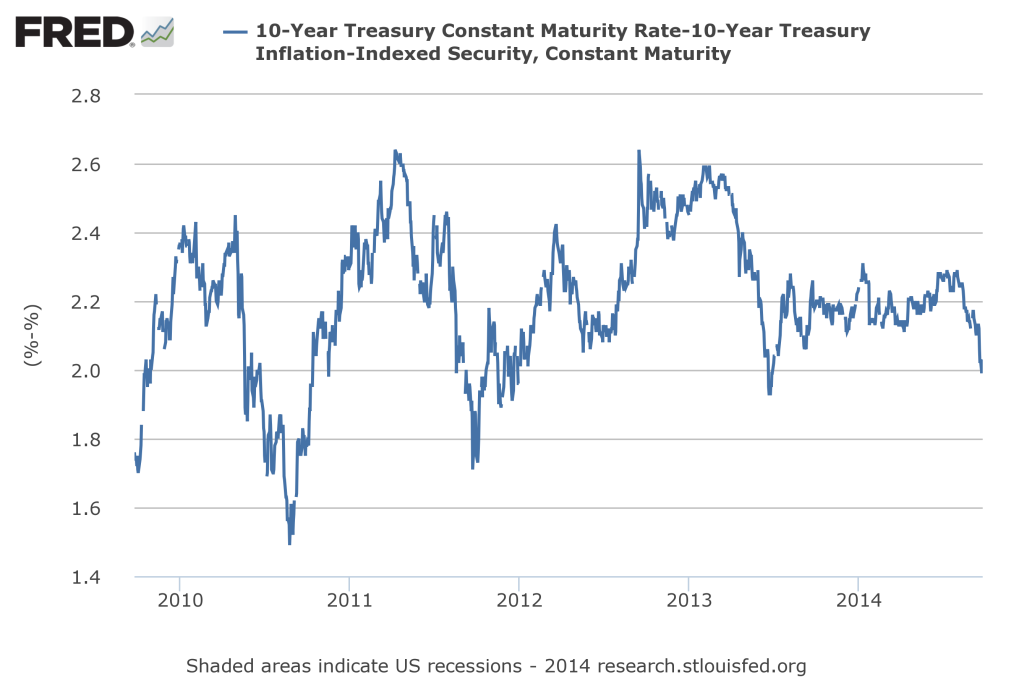Looking backward delivered another inspirational session for the bulls in the land of macro today. The US economy grew faster than previously estimated in the second quarter, according to this morning’s revision from the Bureau of Economic Analysis. GDP expanded 4.6% during the three months through this past June (real seasonally adjusted annual rate). That’s the best pace since the end of 2011 and a healthy improvement over last month’s 4.2% gain for Q2. But if growth is picking up, why is Mr. Market’s inflation forecast going down?
A markets-based view of inflation expectations based on government securities (10-month Treasury yield less its inflation-indexed counterpart) has recently dipped to around 2.0% over the past week or so. The 1.99% level in the daily data for September 22 is the lowest since last June, although the numbers for yesterday (Sep. 25) moved up a bit to 2.02%, according to the Treasury’s daily numbers. The key takeaway is that inflation expectations have dropped substantially since the recent peak of just under 2.30% in July.
That’s hardly a radical change in the outlook, although it’s odd once you consider that the central bank is widely reported to be on track to start squeezing monetary policy in the near future. The current thinking is that the Federal Reserve will begin raising interest rates at some point next year. Today’s GDP data certainly doesn’t offer a reason to think otherwise. But as preludes to higher yields go, the recent decline in the market’s inflation forecast is a curious development. It may also turn out to be a troubling development if it rolls on, although the jury’s still out on what the latest fade for predicting inflation means. There are, however, several possibilities to consider.
The first is simply that the slide in expectations of late is noise. This is always a plausible analysis when it comes to reading the real-time tea leaves of asset pricing, at least until we see a substantial change that prevails. It’s too soon to dismiss this possibility, although we’ll know more in a week or so.
An alternative view is that the rosy aura with regards to the state of US macro is less encouraging than it seems. Although the growth has made healthy progress in recent months, the improvement is hardly beyond criticism. Indeed, a number of August reports were surprisingly weak, including nonfarm payrolls and industrial production. Yes, this could be short-term noise as well, but the argument that the macro trend is accelerating remains open for debate. After all, an economy that’s becoming stronger implies higher inflation.
Should we pay attention to Mr. Market’s signals on the outlook for inflation? Yes, according to Minneapolis Fed President Narayana Kocherlakota, who advised earlier this week that “we need to be very cautious and careful about starting to raise rates, because we do want to be sure that inflation is on the path back to 2 percent.”
Some analysts say that it’s all about trends beyond US shores. Europe’s troubles come to mind as one example. The state of the economy on the Continent is wobbly at best, although the case is stronger these days for anticipating a new recession in the Eurozone. As a pre-emptive strike, the European Central Bank is juicing liquidity again, if only on the margins. But a new phase of rolling out bigger monetary guns in the form of quantitative easing—buying assets with newly printed money—may be near for the ECB. No wonder, then, that yields in Europe are trending lower. Germany’s 10-year yield, for instance, has been inching lower lately, falling to around 1% lately vs. 1.90% at last year’s close. The yield on a nominal US 10-year, by the way, is more than twice as high, at around 2.50% at the moment.
The point is that with yields falling in Europe, there’s a growing incentive to hold higher-yielding US debt. As a result, rising demand for Treasuries is pushing yields in the US lower for reasons that are less about disinflation and weak growth in America vs. the search by foreigners for a safe haven in the world’s reserve currency.
Sorting this out in terms of what the market’s lower inflation assumptions mean for the US economy, if anything, will take time. Meanwhile, some things are still clear, as New York Fed President William Dudley explained on Monday. “We really need the economy to run a little hot, at least for some period of time” to raise inflation to a level that’s consistent with the Fed’s target. For the moment, there’s a bit more uncertainty about when the central bank can declare victory on that front.
